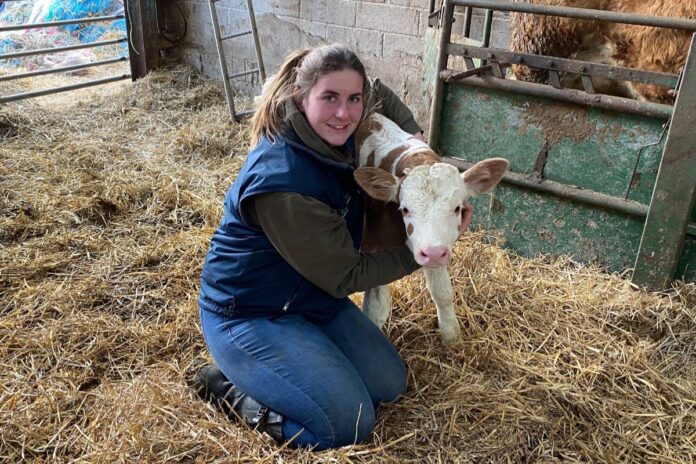In this week’s women in ag segment, That’s Farming profiles Katie Boyes (28). We discuss the transition from dairy to sucklers, her passion for Simmental cattle and improving on-farm efficiencies in Deerholme Grange.
“I am lucky to have been born into farming; I am the fourth generation here at Deerholme Grange.”
Those are the words of Katie Boyes, who hails from a suckler farm comprising just under 100-acres in Malton, North Yorkshire.
“Up until recently, I have always worked on a dairy farm. The farm I worked on was a robotic system with 130 cows. Unfortunately, those cows were sold, and I have just started working for Genus as a Relief RMS Technician,” she That’s Farming.
From dairy to sucklers
Previously a dairy and small-scale poultry enterprise, the farm transitioned into suckler cows in 2005.
“As we were a very small herd, it was not viable for us to continue with the dairy. However, we bred our own suckler replacements from those dairy cows, and they were a great cross.”
At present, Deerholme Grange consists of 35 commercial and pedigree suckler cows. Limousin and Simmental are the main breeds within the enterprise, with some Charolais and Aberdeen Angus breeding females.
“Currently, our numbers are down after having a few disasters and culling hard in previous years. We did get up to 50 cows, but that was just far too many for the grassland we have available.”
“Our happy medium would be just over 40. We have plenty of heifers coming in next year to bring us back up to this mark.”
“We used to buy in dairy-cross heifers and rear them, so that is why we have cross-bred cows. Now, we do not buy many calves in and use home-bred heifers.
She favours the Simmental breed primarily for its docility, ease of maintenance and milk production abilities.
Breeding system and indoor calving
In 2017, she purchased her first pedigree heifer, Helga, from a pedigree herd in Sledmere. Moreover, she acquired another heifer, Regina, from York Pedigree sale two years later.
They run around six pedigree cows with a group of replacement heifers coming through the pipelines.
The stock bull runs with females in the herd from June 1st onwards.
“I aim to AI more of the pedigree stock, including heifers. As I have just started with Genus, I will be using a lot more AI on our cows,” she explains.
“Calving takes place from the middle of March onwards. We like to calf inside so we can keep a close eye on the cows. We give them a pre-calving drench and mineral, so we need them inside for that.”
“I believe that the calves are stronger for turnout in spring, and usually, the worst weather has passed at this stage. We prefer to dehorn before calves are turned out to grass, too.”
Preferences and progeny
This farmer’s ideal cow would be more of a medium-sized animal in the region of 600 to 700kg. Furthermore, she is trying to achieve a polled line of breeding.
In her view, “there are a few great polled bulls out there, and it’s great to have one less thing to do with the calf”.
“However, my preference is a roan cow, with plenty of colour to her. For me, a must is a great udder, or they will never rear a calf.”
They aim to calf-down heifers at around 30 months to give them adequate time for growth and feel that anything older can cause “some problems”.
Moreover, they finish all their bulls for dead weight, going through York Market and ideally aiming for £1,800. Some bulls they sold recently were over the 840kg mark at 16 months.
“I prefer bulls to be over 650kg when they, as we sell live the grades and fat class do not bother me. However, I would aim for an R3 or R4.”
“Previously, we sold heifers which were making in the region of over £1,000. We will be fattening the heifers that we are not using for breeding, as we have plenty of room and barley for feeding.”
Improving on-farm performance
Their culling policy is that any cow with two or fewer teats are removed from the herd. If a cow does not rear a calf that year, they will cull her “unless she is a favourite”.
She wishes that the herd could achieve one calf per cow per year, but it is something she is working towards heavily, but “somehow it never does happen for us”.
“We are trying new ways of reducing our losses. We installed a calving gate for ease and speed. At present, I am looking into purchasing a calving camera for spring calving. We need to work on our calf mortality rates.”
“I believe the key elements of running a successful suckler operation is to not overstock yourself, the cows need space, and they also need grass. In addition to this, care at calving time is crucial. Do not take your eye off the ball; getting a live calf is crucial.”
Simmentals are here to stay
She desires to improve the Simmental herd’s genetic composition, remove cross-bred cows and move to an all pedigree herd in the next five or ten years.
Two big factors within the herd that she is focusing on for the future are mortality rates and finishing age.
“I believe there are some tricky years ahead. Farmers who have been reliant on Basic Payment Scheme payments will struggle to find that extra cash.”
“For me, I grew up with pet cows and have always had a huge passion for stock and their welfare. My love for the Simmental breed was definitely influenced by my father and the Simmental cross-bred cows we bred all those years ago.”
“I think sometimes you just know whether or not you are meant to be a stock person,” she concluded.
To share your story, email – [email protected]
See more women in ag profiles.





